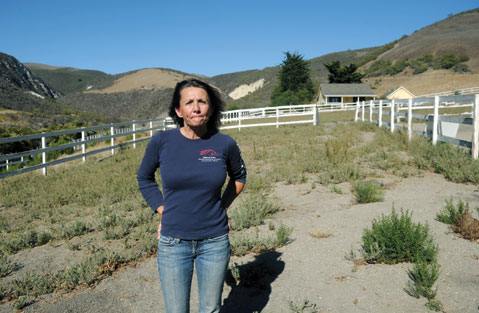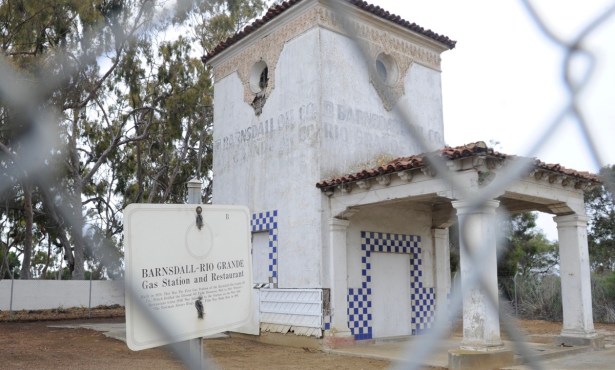Conservationist’s Lompoc Land Deal Goes Awry
County Sees Eminent Domain as Only Option in Tiger Salamander Habitat Case

Eight years ago, the County of Santa Barbara accepted responsibility for killing two tiger salamanders, a federally protected species that lives in rural ponds and vernal pools, and the wheels of bureaucracy have been slowly grinding ever since to make things right. But along the way, the woman who tried to save the county from the expensive wrath of federal wildlife officials says she’s been most thoroughly wronged and is dismayed that the county is now blaming her for the need to unleash its powers of eminent domain — the government’s right to take private property for public use — to finalize the deal.
“This could have been handled with the feathered touch of diplomacy,” explained Sonia Wisniewska, formerly Anderson, who let the county create habitat and a conservation easement for the rare creature on 16 acres of her ranch near Lompoc, in hopes of showing her regulation-fearing North County neighbors they could work with the government toward mutually beneficial results. “Instead, they came out with the A-bomb,” she said.
The specifics of the real-estate transactions that led to today’s situation are tremendously complicated, and there are fundamental disagreements about who should have done what and when. But everyone agrees that the “A-bomb” of eminent domain is a last resort, especially in an agricultural region where worries about further regulations are already explosive.
“This is not the county’s preferred route. It is the only option.”
“Had there been an easy and straightforward way of doing this, like sitting down and signing some paperwork, the county would have done so,” explained Renée Bahl, the county’s assistant CEO, who clarified that the move is to simply record the easement, not acquire the land itself. “This is not the county’s preferred route. It is the only option.” Even ultra-conservative Supervisor Peter Adam, whose 4th District includes the property in question, has accepted that this is the only way to record the conservation easement. As he explained during the May 21 hearing that kicked off the eminent-domain process, “We may be in a box that we can’t get out of.”
Liens and Contracts and Loans — Oh My!
With tiger salamander blood on their hands and the U.S. Fish & Wildlife breathing down their necks, County of Santa Barbara officials spent years trying to find a property that was suitable for creating salamander habitat. Wisniewska’s remote property — a 160-acre ranch located three miles up Gypsy Canyon amid the Sta. Rita Hills wine grape appellation — offered an attractive solution. “I bought the land in a critical habitat zone because I am a conservationist,” she explained. “It is my goal to put land into conservation.” So in 2010, the county paid her $240,000 for the deal, began setting up the new ponds, and asked Wisniewska to get the other lienholders — then, Wells Fargo and Santa Barbara Bank & Trust (SBB&T) — to agree to the easement.
“You have a legal team, and you have real-estate experts who work for you, and you’re gonna leave it up to some random individual to go out and protect your interest?” asked Haugan. “That, to me, is absolutely silly.”
That’s where things got a little messy. The county says that only Wisniewska would have been able to get the lenders to approve the easement because she was the one who had the loans. But Wisniewska and her supporters — including her friend, Robert Haugan, the attorney who now owns the property after buying her out — find that arrangement to be suspect, and they wonder why the county would have cut the check without finalizing the deal. “You have a legal team, and you have real-estate experts who work for you, and you’re gonna leave it up to some random individual to go out and protect your interest?” asked Haugan. “That, to me, is absolutely silly.”
Regardless, Wisniewska believes that she did present the county with all of the paperwork and signatures required to seal the deal but that the county’s real-estate agents moved as “slow as molasses on a cold, wintry day” and “bumbled the transaction” by producing a “flawed document.” At the last minute, the Land Trust for Santa Barbara County, which was to hold the easement, dropped out of the picture when Wells Fargo wouldn’t pay for further review of the contract. But with federal officials losing patience, the county needed to finalize the transaction anyway, so they added a two-year window to get the lenders on board and paid Wisniewska. At that point, she claims that county officials told her not to worry about the easement agreement and that they — none of whom are still employed by the county, incidentally — would handle it.
Wisniewska didn’t worry until a couple of years later when she went through a divorce and fell on hard times. By summer 2012, the banks were ready to foreclose on the ranch, and Wisniewska realized they would be doing so without the conservation easement in place. So to protect the deal and stall foreclosure, she made the only move left. “I threw myself into the flames and filed for bankruptcy,” said Wisniewska.
The county is not admitting any mistakes, but Bahl agreed that the whole deal was “unusual” and a “bit of an anomaly.” She explained, “This was the only land they could come up with, and the county knew there were risks associated with it.”
Who’s Holding the Bag Now?
Today, though Wisniewska still lives on the property, it is officially owned by Wells Fargo and Haugan, who bailed her out and also acquired the liens once owned by SBB&T. When the county hit Haugan with the eminent-domain plans earlier this year, he foreclosed on the property without the conservation easement in place. But Wisniewska believes that, even now, the county could get the easement recorded if they just reached out to Haugan and Wells Fargo rather than pursuing the controversial and expensive steps required of eminent domain. The county’s Los Angeles–based eminent-domain attorney, Duff Murphy, did not think that was possible. “If they say they are ready to subordinate,” said Murphy, “have them give me a call.”
Haugan would be happy to do so, though he’d want to be compensated, and there seems to be a wide gap between what he wants (he proposed $175,000 as a starting point, figuring that would get chopped down) and what the county will pay (Haugan heard that they were thinking more like $40,000). Wells Fargo’s position is unknown, as a call to the bank’s attorney Glenn Wechsler was not returned, and attempts to get a response from anyone associated with this property inside the bank were unsuccessful. But mortgage experts contacted for this article questioned why a bank would ever agree to a conservation easement that devalues an already highly leveraged property, especially back in the comparably cash-strapped times of 2010.
“We already purchased the conservation easement,” said Bahl. “We are securing the investment we made.”
No matter what, Haugan believes that negotiating would be smarter, more predictable, and, ultimately for taxpayers, a cheaper move than the risks and legal costs associated with eminent domain, in which a judge will decide the final outcome. Among other findings, that judge will have to decide whether this is a new deal, which would require the county to pay again in full, or merely the end of the first deal, which would mean less of a payout. That’s what the county is betting on. “We already purchased the conservation easement,” said Bahl. “We are securing the investment we made.”
Currently, the eminent-domain case is set for its first hearing in November, at which point Wisniewska’s dream of showing farmers and ranchers how easy it would be to save the tiger salamander with government help will be over. Instead, their fears about regulators coming in and forcibly taking land will be confirmed. “This is going to perpetuate that negative perception, and that upsets me,” said Wisniewska. “I wanted to set an example for my neighbors that, instead of destroying this habitat, they should nurture it. Instead, the county is making everyone’s worst nightmare come true.”



